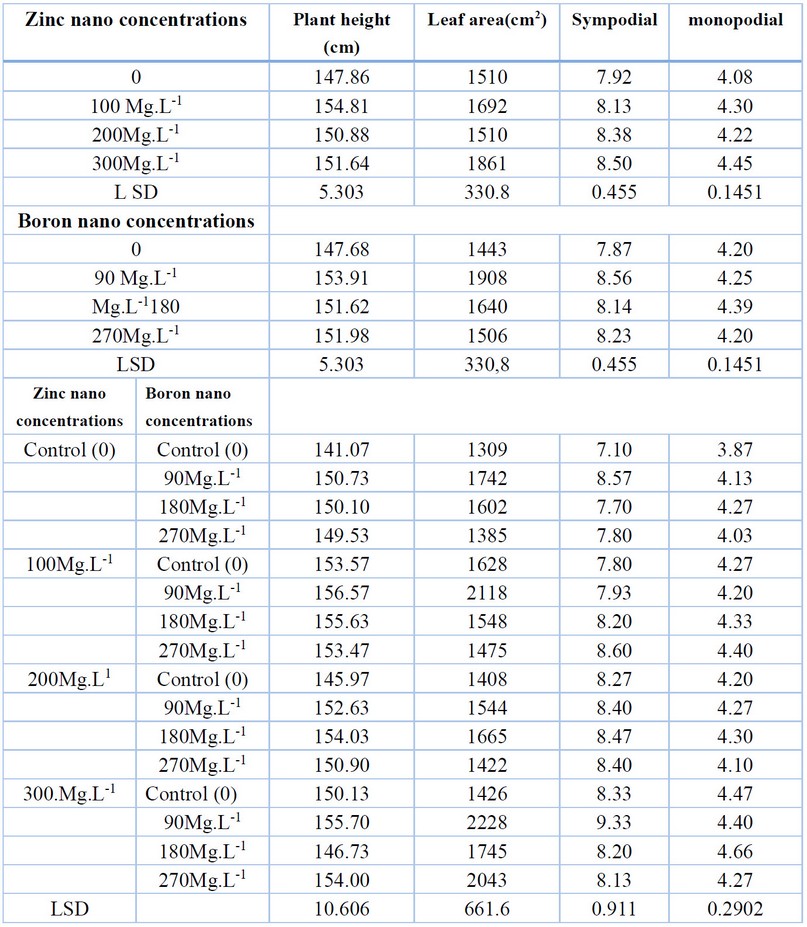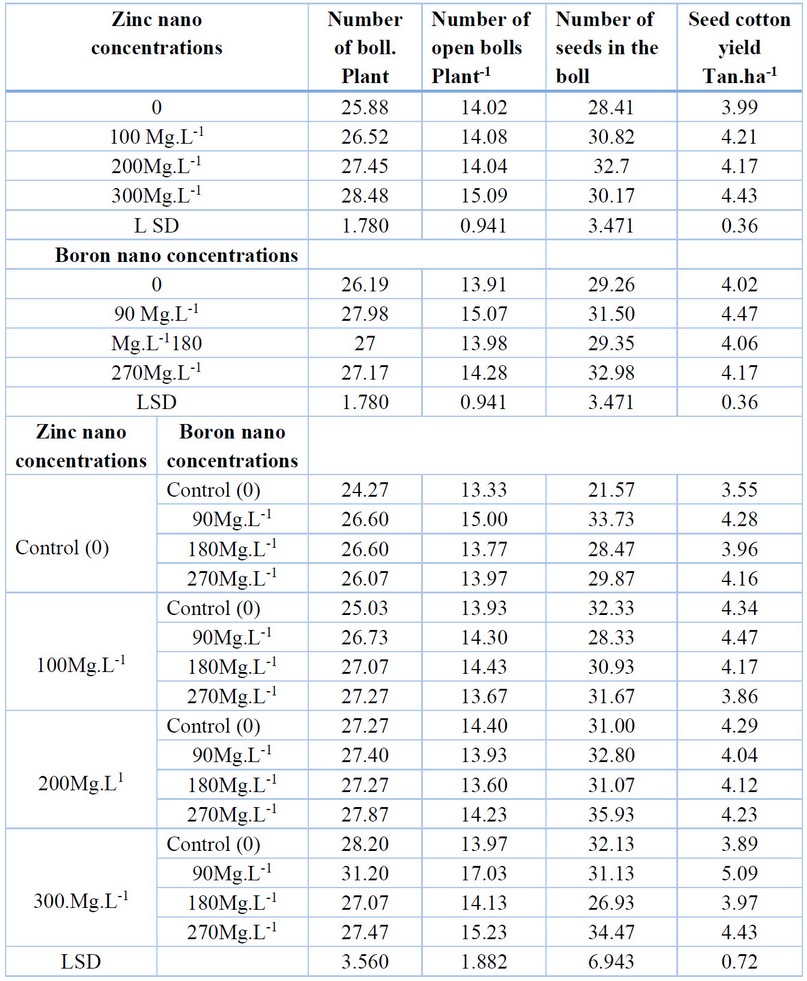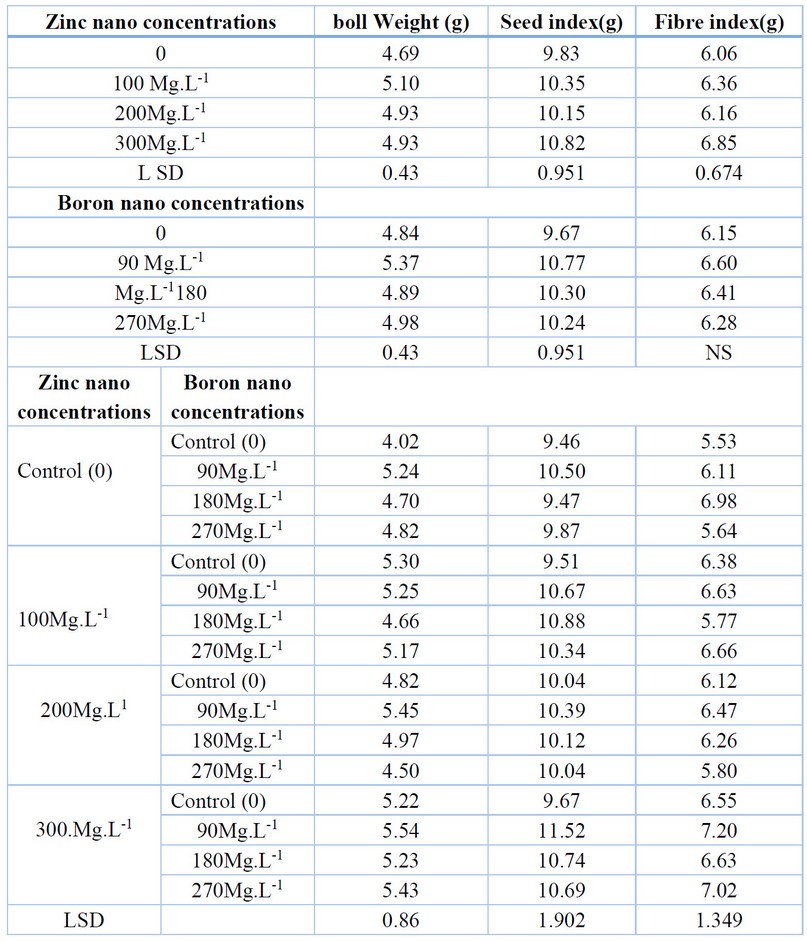2022.07.04.41
Files > Volume 7 > Vol 7 No 4 2022
Effect of nano-zinc and nano-boron spraying on cotton growth and yield
1Department of Field Crops-Agriculture Collage –University of Kerbala. Iraq. E.mail. [email protected]
2Department of Field Crops-Agriculture Collage –University of Kerbala. Iraq
* Correspondence author. [email protected] Tel.:009647801677133
Available from: http://dx.doi.org/10.21931/RB/2022.07.04.41
ABSTRACT
A field experiment was carried out in one of the fields of Karbala Governorate - Iraq, during the summer agricultural season of 2021 to know the effect of spraying with nano-zinc and nano-boron on some characteristics of cotton yield. The experiment was applied in three replications according to the randomized complete block design (RCBD) with two factors; the first factor included four levels of Nano-zinc (0, 100, 200, 300) mg L-1. The second factor included four levels of Nano-boron (0, 90, 180, 270) mg L-1. The concentration of 300 mg L- a of Nano-zinc caused a significant increase in the leaf area number of monopodial, number of sympodial branching, total boll number per plant, number of open bolls per plant, boll weight, number of seeds per boll, Seed index and Fibre index, as it gave averages of leaf area 1861 cm2, 8.50 branches Plant-1. 4.45 branches plant-1, 28.48 bolls plant-1, 15.09 bolls plant-1, 10.82 g, 6.85 g, respectively. The results also showed that Nano-boron caused a significant increase in the studied traits, where the concentration is 90 mg L-1, which caused a significant increase in plant height, leaf area number of monopodial, number of sympodial branching, total boll number per plant, number of open bolls per plant, boll weight, number of seeds per boll, Seed index and Fibre index. It gave averages of leaf area 153.91 cm, 1908 cm2, 8.56 branches plant-1, 27.98 boll plant-1, 15.07 boll plant-1, 5.37 g, 10.77 g, and 6.60 g, respectively. It is concluded that adding zinc and boron, singly or together, to the vegetative system improved cotton growth characteristics and yield.
Keywords Nano fertilizer, foliar, zinc, boron, cotton
INTRODUCTION
Cotton is one of the essential economic crops because it contains fiber and oil. It also can persist and survive in different environments, as some cotton can adapt to such environments and produce high-quality fibers 1. Still, the deterioration in the productivity of the cultivated varieties has caused. It is due to the lack of fertilization with micro-nutrients, which leads to an imbalance in the nutritional balance or thus affects the growth of the plant2. To preserve the environment from the risk of pollution, Nano-fertilizers were used as well to reduce time and effort. Foliar feeding with nutrients is essential in changing cotton's growth and physiological characteristics through fertilization strategies. Foliar spray fertilization leads to improving the efficiency of fertilizer use and reducing the environmental pollution. It has also been proven that fertilization with foliar feeding of mixtures of micronutrients during the flower or nut development stages is adequate when optimal use of nutrients. With cotton, thus reducing the rate of walnut shedding and increasing the yield,3 indicated that foliar feeding helps to reach the nutrients to the places of their representation4. Indicated that it is preferable to use foliar feeding when there is a problem in the soil, such as its ability to sediment and fix nutrients and high salinity as it reduces. The readiness and absorption of these elements5.indicated that the application of nanotechnology in agriculture leads to improving the environment and increasing crop quality and production of crops6. Nano fertilizers are characterized by their small size and large surface area, which leads to an increase in yield. Zinc and boron are considered nutrients. The essential microelements for plants and animals and zinc have a vital role in the plant's metabolic system, as this zinc activates the participation in the formation of proteins, fats, carbohydrates, DNA and enzymes7. Zinc also plays a significant role in controlling the production and toxicity of free radicals that can be caused damage to membrane lipids8. Zinc deficiency leads to a decrease in vegetative and fruitful growth 9. Using zinc by spraying on leaves leads to Increasing the number of flowers, number of seeds per boll, and cotton yield 10,11. Boron contributes to the transfer of sugar particles and sources of filling, leading to improved fruits and increasing vegetative growth and seed formation. Indicated that spraying with boron at concentrations (0.0.56.1.12) kg/ha led to a significant increase in bolls, boll weight and cotton yield12. It was also found (13) when using seven treatments of zinc and boron with the following concentrations (0 + 0, 0.75 + 0, 0 +1, 0.75 + 1, 1.50 + 0, 0 + 2, 1.50 + 2) added by spraying on cotton, that 0.75 kg/ha of zinc with 1.00 kg.ha-1 caused a significant increase in the number of bolls, cotton yield and boll weight13. (14) showed a significant increase in cotton yield due to spraying zinc and boron. (15) when studying the effect of three concentrations of boron on the growth and yield of cotton indicated that boron caused a significant increase in the number of bolls and cotton yield. This study examines how spraying with zinc and nano-boron affects cotton growth and yield characteristics.
MATERIALS AND METHODS
A field experiment was carried out in the holy city of Karbala during the summer of 2021 to find out the effect of spraying with different concentrations of Nano-zinc and Nano-boron on the growth characteristics and yield of cotton. The experiment was applied with three replications according to a randomized complete block design (RCBD) with two factors; the first factor included four levels of Nano-zinc ( 0, 100, 200, 300) mg L-1 and four treatments of Nano-boron (0, 90, 180, and 270) mg L-1. The fertilizer was randomly sprayed on the vegetative system of the plant, as the Nano-zinc used is from the chelating fertilizers that contain zinc in it 12%, and the Nano-boron used is from the chelating fertilizers that contain boron (9%). Nano zinc and Nano boron were sprayed when the plant reached the flowering stage by 50% after the absence of the sun.
Plants were randomly selected from each experimental unit. The following characteristics were measured: Plant height(cm), leaf area (cm2), number of monopodial (branches plant-1), number of sympodial branching (branches plant-1), total boll number per plant (boll plant-1), number of open bolls per plant (boll plant-1), boll weight (g), number of seeds per boll (seed boll-1), Seed cotton yield (Ton h-1) , Seed index and Fibre index.
RESULTS AND DISCUSSION
Table 1 shows that there were significant differences between the treatments of nano-zinc, where the concentration of 300 mg L-1 gave the highest average in leaf area, number of ), number of monopodial (branches plant-1), number of sympodial branching (branches plant-1), with averages amounting to 1861 cm2, 8.50 branch. Plant-1,4.45 branch Plant-1, superior to the non-spray treatment. While the concentration of 100 mg.L-1 gave the high est average plant height of 154.81 cm. The reason is that zinc is essential in forming enzymes as it is a functional and structural cofactor and biomass production and is also required in producing chlorophyll and regulating enzymes16. At the same time, the deficiency of zinc in cotton leads to the small size of the leaf, its wrapping and its appearance it17. The results of Table 1 also showed that Nano-boron caused a significant increase in the studied traits; the concentration 90 mg L-1 gave the highest average in the plant trait: height, leaf area, number of sympodial branching with standards of leaf area 153.91 cm, 1908 cm2, 8.56 branch Plant-1 superior to no-spray. The boron deficiency affects the growth and yield of cotton as a result of reducing the transfer of material represented to the stalk through vascular bundles, which stops growth or causes abnormal development of the cotton reproductive parts of cotton18. And when spraying the solution (Zn + B) together on the vegetative treatment of cotton plants led to a significant increase between treatments, the concentration of 300 mg L-1 of Nano-Zn with 90 mg L-1 of Nano-boron gave the highest average in leaf area. The number of sympodial branches, which provided an averages leaf area of 2228 cm2, 9.33 branch Plant-1, respectively, is superior to no spraying, and this is because zinc and boron cause an improvement in the absorption site and its transfer of plant nutrients to plant parts and an increase in photosynthesis, which in turn causes an increase in growth characteristics, and this is consistent with what was stated19.

Table 1. Effect of nano zinc–boron spray on the same growth traits of cotton.
Table 2 shows that there were significant differences between the treatments of Nano-Zn in the number of total bolls, the number of open bolls and the number of seeds per bolls, the concentration of 300 mg.L-1 caused a significant increase in the number of total bolls, the number of open bolls, as it gave averages of 28.48 bolls plant-1, 15.09 bolls Plant-1, respectively, superior to the non-spray treatment that offered the lowest standards. This trait increase may be due to the role of zinc in the production of IAA auxin, which prevents the dropping of buds, flowers and bolls and the rise in the number of branches17. This is in agreement with16. It was also noted that the Nano boron caused a significant increase in these characteristics, as the concentration of 90 mg L-1 of Nano boron gave the highest rate in the total number of bolls, and the number of open bolls amounted to 27.98 bolls plant-1,15.07 bolls plant-1, respectively. It is superior to the non-spray treatment that gave the lowest averages, and the reason for this increase is that boron controls the growth of meristematic cells, so when it is lacking, no change occurs at standard rates. The transfer of sugars and the increase in the rate of photosynthesis enhances the growth of flowers and seeds, which increases the number of bolls12, .and this is consistent with what was reached15. The results also showed that spraying zinc and boron together caused a significant increase in the studied traits, the concentration (300 +90) mg L-1 of Nano-zinc and Nano-boron caused a significant increase in the total number of bolls and the number of open bolls, as it gave averages of 31.20 bolls plant-1, 17.03 bolls Plant-1, respectively, superior to the no-spray treatment that gave the lowest standards.

Table 2. Effect of Nano zinc – boron spray on the same productivity traits of cotton
Table 3 showed that Nano-zinc led to a significant increase in bolls weight, seed index and Fibre index. The concentration of 300 mg L-1 of Nano-zinc caused a substantial increase in seed index and Fiber index, as it gave averages of 10.82 g and 6.85 g, respectively, superior to the non-spray treatment that offered the lowest standards. The reason is due to the role of zinc in cell formation and seed development, as zinc deficiency causes a decrease in the number of bolls and thus their small size 21, 22, 23. The treatments of Nano-boron also caused a significant increase in bolls weight, seed index and Fibre index, the concentration of 90 mg L-1 gave the highest averages of 5.37 g, 10.77 g, and 6.60 g, respectively, superior to The non-spray treatment that offered the lowest standards. The reason is due to the effective role of boron in the vital processes of the cotton plant and its role as well in the transfer of sugars from the leaves to the fruits, as it is necessary to fill the seeds and improve the quality of the bolls24 and this is consistent with 25. The spraying of Nano-zinc and Nano-boron together gave an increase in all traits, and spraying with 300 mg L -1 + 90 mg L-1 of Nano-zinc and Nano-boron caused a significant rise in bolls weight, seed index and Fibre index, as it gave averages amounting to 5.54 g, 11.52 g, 7.20 g, respectively, and this is consistent with what was stated25.

Table 3. Effect of nano zinc–boron spray on the same productivity traits of cotton
CONCLUSIONS
It is concluded from this study that spraying zinc and boron caused a significant increase in all growth characteristics and cotton yield, so we suggest spraying a concentration of 300 mg.L-1 of nano-zinc and a concentration of 90 mg.L-1 of nano-boron to increase the yield and quality of cotton.
Author Contributions: Conceptualization, Fadil, NM; Alfarttoosi, H.A.Kh..; methodology, Alfarttoosi H.A.Kh, formal analysis, Alfarttoosi, H.A.Kh.; resources Fadil, NM; data curation, Fadil, NM; writing—original draft preparation, Fadil, NM writing—review and editing Fadil, NM; supervision Alfarttoosi, H.A.Kh.; project administration, Alfarttoosi, H.A.Kh.;
Funding: This research received no external funding
Institutional Review Board Statement:) "Not applicable."
Informed Consent Statement: "Not applicable."
Data Availability Statement The study did not report any data.
Acknowledgments: Department of Field Crops- Agriculture Collage –University of Kerbala
Conflicts of Interest: The authors declare no conflict of interest.
REFERENCES
1. Yoo, M.J.; Wendel, J F. Comparative evolutionary and developmental dynamics of the cotton (Gossypium hirsutum L.) fiber transcriptome2014. .PLoS Genet.10(1): e 1004073.doi: 10.1371/Journal. Pgen .1004073..
2. Molly, R. M. M.Effect of boron and cotton growth and production. 1991. Iraqi J. Agri. Sci 22 (1) 43.51
3. Radhika, K.; Katharina, P.; . Maragathan, S. ; Kanimozhi, A.Foliar application of micronutrients in cotton .A review .Res. and Rev., 2013. 2(3):23- 29.
4. Kaya, C. ; Higgs, D. ; Kinak, H. Influence of polyethylene mulch , irrigation regime and potassium rates on field cucumber yield and related trails. 2005 . J. Plant Nutr, 28(10):1739-1753.
5. Bednarz, C.W. ; Bridges, DC; Brown, S.M. .. Analysis of cotton yield stability Across population densities. 2000. J. Agron.92:128 -135.
6. Rezaei, M. ; Abbasi, H. Foliar application of Nano chelate and no Nano chelate of zinc on plant resistance physiological processes in cotton (Gossipium hirsutum L.) .2014. Iran. J. Plant Physiol.,4(4).1137-1144
7. Khan, M.; Umar, S .; Qasim, M. ; Jamil, M. 2002 . Effect of different Levels of Zinc on the extractable Zinc content of soil and chemical composition of rice . Asian J. Plant Sci. 1(1) : 20-21
8. Alloway, D . 2008 . ' Zinc in soils and crop nutrition ' Published by IZA and IFA Brussels, Belgium and Paris ,France , 135p.
9. Pathak, G. C. ; Gupta, B. ; Pandey ,N . Improving reproductive efficiency of chickpea by foliar application of zinc. 2012. Brazilian J. Plant Physiol , 24(3):173 -180
10. Mullins, M. G. A. L . E. Bouquet. Biology of the Grapevine . Cambridge Universtiy Press , Cambridg. 1992 .
11. Prasad, M . ; Prasad, R. Response of upland cotton to micronutrients and sulphur . 1998 .Indian J.Agron ., 35: 707 – 70
12. Görmüöş, Ö. Interactive Effect of Nitrogen and Boron on cotton Yield and Fiber Quality .,Cukurova University ,Faculty of Agriculture , Department of Field Crops01330 Adana –TURKEY2005. 51-59.
13. Ali, L . ; Ali, M. ; Mohyuddin, Q. . Effect of foliar application of zinc and boron on seed cotton yield and economics in cotton – Wheat cropping pattern Adaptive Research Form ,Vehari , Pakistan., J. Agric . .2011 . Res, 49 (2):73-80.
14. Rashid, A . ; Rafiq, E.. Boron and zinc fertilizer use in cotton importance and recommendation. PARC, Islamabad.2000.
15. Yas, A. A. Effect of phosphorus and boron fertilization on the growth of seed cotton and its component var . Lashata (Gossypium hirsutum L.) ,special issu Tikrit University – Faculty of agriculture conference23-34-March -2014-242-247
16. Efe, L ; Yarpuz, E. The effect of zinc application methods on seed cotton yield , lint and seed quality of cotton (Gossypium hirsutum L.)in east Mediterranean region of Turkey. African J. Biotech. 2011. 10(44):8782-8789.
17. Irshad, M. ; Gill, M. A.; Rahmatullah, T. A. ; Ahmed, I. . Growth response of cotton cultivars to zinc deficiency stress .Pak.J.Bot . 2004.36(2) :373-380
18. Dong, J. F. . The yield increasing ability of spraying cotton with boron . Journal of Henan AgricultureSciences1995 . .3:6
19. More, V. R; . Khargkharate, V. K ; Yelvikar, N. V. ; Matre, Y. B. '' Effect of Boron and Zinc on Growth and Yield of Bt Cotton under Rainfed Condition .Int . J . Pure App. Biosci. 2018. 6(40) : 566 – 570
20. Shah, J.A. ; Zia-Al-Hassan, S. ; Rajpar, I.; Sial, M. A. Response of cottongenotypes to boron under B-deficient and B-adequate conditions. Pak J Bot. 2015; 47: 1657–1663.
21. Oosterhuis, D.M. ; Robertson, W.C. ; McConnell, J .S.; Zhao, D. .. Characterization of boron use by cotton in Arkansas. Proceedings of the 2000 cotton Research Meeting. University of Arkansas Agricultural Station , Experiment Special Report .2000. 198:72-76 .
22. Rezaei, H.; Malakouti, M. J. Critical Levels of Iron, Zinc and Boron for Cotton in Varamin Region J. Agric. Sci. Technol.2001. ( 3): 147-153.
23. Al-Naqeeb, M. A.; Al-Hilfy,I. H . H; Humood, W. F.; Al-Abodi, H. M. K.. Effect of zinc and boron on growth and yield of cotton. Iraqi J. Agri. Sci. 2010. ( 41) 6 : 11 – 20.
24. HeitholJ, J. T.Supplemental boron, boll retention percentage, ovary carbohydrates and lint yield in modern cotton. genotypes .Agron. J. . 1994. 86:492- 497
25. AL-Assaf, M. A.; Raad L. A. Effect of spraying boron on growth and yield of three varieties of cotton ( Gossypium hirsutum L.) Al Anbar J. Agric. Sci . 2011. 9 (1).
Received: August 25, 2022 / Accepted: October 12, 2022 / Published:15 November 2022
Citation: Fadil, NM; Alfarttoosi, H.A.Kh. Effect of nano-zinc and nano-boron spraying on cotton growth and yield. Revis Bionat a 2022;7(4) 41. http://dx.doi.org/10.21931/RB/2022.07.04.41
